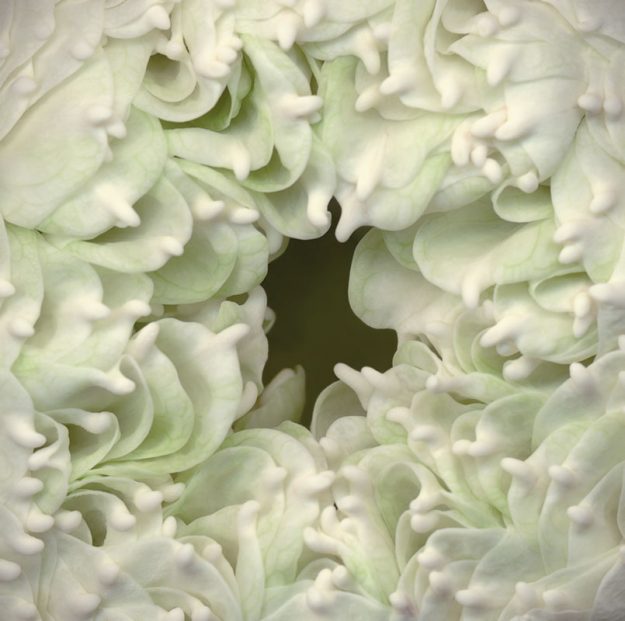When Buddha was on Vulture Peak he twirled a flower before the assembly. Everyone was silent. Only Mahakashyapa smiled. Buddha said: “I have the eye treasury of the true teaching, the heart of nirvana, the true form of non-form, and the ineffable gate of dharma. It is a special transmission outside the teaching. I now entrust it to Mahakashyapa.”
This account of Shakyamuni Buddha’s first authentic, heart-mind transmission of his teaching is found in a thirteenth-century Chinese koan collection, the Wumenguan. It is not historically true, but it isn’t exactly made up either. Over the years I’ve come to appreciate that the story expresses something spiritually accurate about the Zen tradition from which it comes. We are trying to practice in accord with and to convey to others the essential wisdom of the Buddha, the kernel of truth within the details and doctrines that have been built up over the generations. The Buddha’s insight, his understanding and way of life, is very simple and straightforward, though it may seem paradoxical or ineffable when we examine it in the context of our normal lives of lunacy. If it seems hard to explain, it’s because the explanations become distorted by our own craziness. But when you have a personal, living feeling for the Buddha’s essential spiritual point, it’s not hard to understand—or to explain. So when someone holds up a flower, a beautiful, delicate, very temporary—and beautiful because temporary—flower, you understand right away, and you smile at the elegance of the explanation.
There is no mention of this story in any of the sutras. But the sutras do refer to Mahakashyapa as one of the Buddha’s main disciples, and Vulture Peak was the setting of some of the Buddha’s most important teachings. I visited Vulture Peak a few years ago, and I was surprised at how small it is, a rather small rounded peak surrounded by other smallish peaks. If a lot of disciples congregated there to hear the Buddha’s teachings, they must have been spread out below, or on the other peaks, so they must have had some trouble hearing him. It reminded me of Monte Python’s Life of Brian, in which the people in the back, hearing the Sermon on the Mount, thought Jesus had said, “Blessed are the cheesemakers” and “Blessed are the Greeks.” It must have been quite easy to misunderstand spiritual teachers in ancient times, without microphones or accurate recording systems. So written scriptures based on these hearings may not be so reliable. In any case, anything written is always incorrect because writing is, by its nature, abstract and out of time, whereas life is always very particular and in time. So even if the scriptures record exactly the words of Buddha, which is highly doubtful, sound system problems aside, these words would still not be quite what we need. Zen describes itself as a “special transmission outside the scriptures,” but I think this applies to all real spiritual truth. There’s nothing special about Zen. Probably all spiritual teachings are essentially “outside the scriptures.”
In texts like the Parinirvana Sutra and the Kalama Sutra, we find the Buddha encouraging his disciples to find their own way to the teachings, not to trust charismatic teachers, tradition, or custom unless what is presented has been verified by personal experience. In the Parinirvana Sutra, the Buddha famously advises his disciples to rely on their own practice and discernment. This is one of the aspects of the Buddha’s teaching that many of us find most attractive and that fits well with our Western culture of critical and independent thinking. Clearly, though, there is more to be said here, because we have been trusting our own experience and intelligence all along and we are still in a mess. It’s not that we need to trust something outside our experience or intelligence. Rather, we need another way, another access point. The story of the Buddha twirling a flower speaks to this alternative access point. To talk about it I will back up a little bit.
In early Buddhism, the Buddha was understood to be a remarkable person who discovered and overcame, through his own subjective experimentation, the root of human suffering, and devised a method for sharing his experience so that others could duplicate it. He spent about forty-five years refining his discussion of that method, and creating a social structure for an organized community that promoted it.

In the Lotus Sutra—a Mahayana text, so important in Far Eastern Buddhism—you get quite a different sense of who the Buddha was and what he accomplished. In this sutra the Buddha reveals that he is not a person at all; he is the eternal principle of the essential ineffable nature of reality. He says that earlier he had pretended to be a person, had faked his birth, aging, and his passing away, because that is what was expected and needed by people at that time. He says that the various painstaking early methods he devised to promote awakening were actually expedient devices, useful for disciples with a limited understanding but not really salient or necessary in reality, and that now, in the Lotus Sutra, he is revealing the deeper truth that nirvana isn’t a state to be attained at some future time through long effort. In fact, nirvana is the real nature of all things, and so no method and no cultivation is or ever was necessary; simply to have faith in the Lotus Sutra’s true teaching suffices. So just holding up a flower would be enough to evoke all teachings, all truths. No more is needed.
While the Lotus Sutra is sprawling and poetic, rather than philosophical in an organized way as other sutras often are, it suggests and supports two crucial Mahayana concepts that are germane to this discussion. One is tathata, or “suchness”—the world as it is, seen in its true aspect, free of our conceptual projections, our ordinary lunacy. The early Buddhist idea of the world as a vale of tears to be overcome by purification and effort is set aside in the Lotus Sutra in favor of a spiritualized world, an eternal world, which is the only real world. The concept of suchness suggests that this true world, beyond our limited views of it, is already a perfect Buddha-land, if only we can open our eye of faith and see it as it is.
A second Mahayana concept supported by the Lotus Sutra teaching is upaya, skillful means. According to the doctrine of upaya, there are no particular fixed means of awakening. One need not be limited by Buddhist practices taught previously, which were, after all, only provisional and limited in scope. In reality, everything is potentially a means to awakening. It is simply a matter of seeing this and knowing how to apply each thing in each particular case. Buddhist practice is not limited to austere meditation, monastic precepts, cultivation of wholesome states, and so on, activities best suited to home-leavers and ascetics. Bodhisattvas practice skillful means to help all beings without exception to awaken. If beings need food, tofu is skillful means; if they need warmth, a blanket is skillful means. There’s nothing that can’t be part of a program for awakening. Everything is practice.
Buddhist practice is not limited to austere meditation.
If the Buddha is not a human being born from his past karma into this world for one last lifetime’s practice, as previous sutras taught, if the Buddha is instead the eternal principle of suchness and awakening as the Lotus Sutra implies he is, then how and why does he appear in this world? The Lotus teaches that he appears not from karma, as do all other beings, but due to the “One Great Causal Condition,” which is the interdependent nature of existence/nonexistence, a field whose true shape and purpose is love. This is a deep and astounding teaching: that far from being a world of trouble and tears as it appears to be, this world of existence/nonexistence, seen in the light of suchness and lived according to upaya, is in reality a world of bliss and awakening. But beings don’t know this. They are awash in a sea of suffering. Reality’s true trajectory is toward relieving this suffering through love.
It seems to me that somehow we all know that love is our real nature and our real goal; we all long to realize this goal, however confused and misguided our longing may be. Being human has embedded right in the middle of it some sense of longing and reaching out for something very, very large, not outside our lives, but as our lives. We are all in search of the One Great Causal Condition, whether we know it or not. The teaching of the Lotus Sutra affirms that this is so, and gives us a way to understand and envision it.
An important saying of the Lotus Sutra, one that is crucial for understanding our story, is that suchness is revealed “by a buddha and a buddha.” A buddha alone cannot realize it; only a buddha and a buddha can. Although we must all rely on our own experience and intelligence, we cannot realize suchness by dint of our own efforts. An appreciation of true suchness can be awakened within us only in radical encounter. “Only a buddha and a buddha” means there are no separate buddhas. There are only points of meeting, moment after moment, world after world, of meeting. All things merge, mix, create, and liberate each other. Nothing is separate and alone. This is how things are. This is compassion, not merely an extra something one of us feels for another, but existence itself. Being is by its nature sharing and loving. And we realize this not as a concept or a method we can work at and finally grasp, but as a truth that we perceive through our mutual recognition, our mutual shared awakening.
SSo Buddha’s dharma talk on Vulture Peak includes no words. He holds up a flower and twirls it. This is his talk, his demonstration of suchness. Only Mahakashyapa understands. As Aitken Roshi points out in his commentary to the koan, the original Chinese literally says “Mahakashyapa’s face cracked.” As we would say, he cracked a smile. Mahakashyapa was sitting there in meditation on Vulture Peak, listening to the great teacher, trying to be serious, as everyone was, as we all are in this very serious world of suffering and trouble, and he sees the flower, just that, a flower. So wonderful, so marvelous! So simple. No words, no explanations, no tragedies, no dramas, just a flower. How odd and funny! Mahakashyapa cracked up.
Life is so unlikely, so miraculous, so pathetic, so hilarious, so transcendent, and so unlike the way we think it is that you crack up when you see the absurdity of all our earnest efforts to push the river, plow the clouds, fix the unfixable, and understand the incomprehensible. A commentary to the koan says that Mahakashyapa and the Buddha smiled one smile: between them there was one smile. They had perfect accord, perfect harmony, perfect relationship, perfect trust. Essentially, there were not two of them. Probably if they had begun to discuss it, it wouldn’t have been so perfect anymore. As soon as you come forth from this perfect center, problems begin. But once you experience things as they really are, free of your confusion about them even for just a moment, you don’t forget about it. You have confidence that your life has a rightness and an integrity to it, despite your many mistakes and limitations. You don’t have to be floored by your troubles. You can deal with the inevitable problems that arise, and you don’t have to be so tripped up by your own blindness and confusion. “Only a buddha and a buddha” is all there ever is.

On what authority do we live our lives? We are always seeking legitimacy with our diplomas and licenses, our birth certificates and death certificates. We cede our authority as individuals to society’s institutions—universities, churches, the state. But below the radar of all of this, we long for a deeper sense of authorization. This may be the fundamental bottom-line source of our unhappiness. We do not feel ourselves to be authors of our lives, and we need to be our own authors, our own authorities. We need to be authentic. We are willing to endure a lot of hardship, a lot of not getting what we want, in order to feel this sense of authority in our living. We can get a lot of honor and wealth and so on, but it won’t mean much if we don’t feel the depth of authority we desperately seek.
In this story we have an instance of the conferring of real authority, not by Buddha to Mahakashyapa, but between Buddha and Mahakashyapa—reality conferring authority on itself. Between them there is trust, the kind of trust that begins and ends with each of us recognizing the suchness of our existence and standing on that ground, coming out to meet another. So it’s once again, as so many true things are, a paradox. Ultimate authority is non-authority. There isn’t any authority that I possess or can get. There is just my life, and my willingness to see my life as it is, and to meet it, moment after moment. Unless I am willing to meet and be met, I have no authority at all.
The authority of suchness isn’t something we can be given, or something we can have that someone else doesn’t have. According to Mahayana tradition, the Buddha said when he was enlightened: How marvelous, everyone is enlightened! Everyone shares automatically in suchness. If it moves, it must be suchness. If it is, it is Buddha. So there’s nothing special here, and nothing extra is needed. Buddha transmits the wonderful mind of nirvana to Mahakashyapa, but there’s nothing to transmit. It’s already transmitted. Life transmits life. Time transmits time. To think there’s something extra to transmit, some secret understanding whispered to the initiated in the middle of the night, is to misunderstand and reduce what is transmitted. In Zen, people who receive dharma transmission know that there is nothing to transmit. In a way it’s a joke, a kind of shell game; no wonder Mahakashyapa cracks up! Yet at the same time you have to transmit it. You have to hold up a flower. There really isn’t a teacher and a student, and at the same time we have to have these relationships and all that goes with them. This is how we activate the One Great Causal Condition of compassion and love. And we must activate it; this is our human obligation, our role, our task, and our joy.
With formal dharma transmission comes a great responsibility. When in silence we twirl the flower in the Great Assembly, and someone smiles, and we smile back, we fulfill that responsibility. But as soon as we open our mouths and start doing things in the world, we for sure fall short of that responsibility. This is sad; I find it sad. Nevertheless, it is human to take up the responsibility. It is necessary. This is what we are all struggling with, what we are all working on.
Thank you for subscribing to Tricycle! As a nonprofit, we depend on readers like you to keep Buddhist teachings and practices widely available.
Copyright 2024. Tricycle. All rights reserved.
Design by Point Five. Development by Code Rodeo
